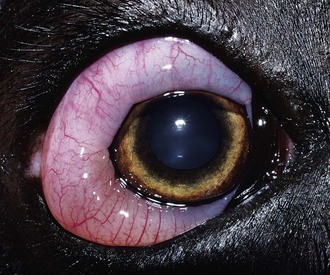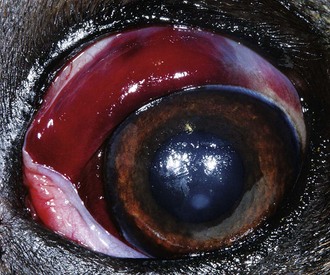Chapter 244 Conjunctivitis invariably is associated with some combination of the following clinical signs: ocular discharge, chemosis, hyperemia, discomfort, pruritus, tissue proliferation, ulceration, and hemorrhage. Ocular discharge may be characterized by serous, mucoid, mucopurulent, or serosanguineous fluids. Epiphora, overflow of serous tears, results from excessive production or inadequate nasolacrimal drainage. Chemosis appears as conjunctival swelling and is the clinical manifestation of conjunctival edema caused by increased vascular permeability and fluid extravasation (Figure 244-1). Hyperemia is a red conjunctival discoloration (“red eye”) and is a clinically observable manifestation of vasodilation and increased blood flow. Ocular discomfort and pruritus most commonly manifest as blepharospasm and periocular rubbing. Figure 244-1 Allergic conjunctivitis in a dog with marked chemosis that occurred immediately following a Hymenoptera (honeybee) sting. Ulceration of the conjunctival epithelium may occur with any severe conjunctivitis but is most common in conjunctivitis of viral or traumatic origin. Conjunctival ulcers appear as flat, irregular, pale or pink regions on the conjunctival surface that retain fluorescein stain and are surrounded by a hyperemic border. Hemorrhage may occur in the conjunctival epithelium or subconjunctival space. Both intraconjunctival and subconjunctival hemorrhages appear as bright or dark red regions of variable shape and size (Figure 244-2). Conjunctival hemorrhage is frequently detected in dogs with traumatic or viral conjunctivitis but also can be a manifestation of systemic disease, including coagulopathy, hypertension, hyperviscosity, platelet disorders, and vasculitis. A complete ophthalmic examination always is indicated for dogs with conjunctivitis, including Schirmer tear tests, ocular surface fluorescein staining, and tonometry (see Chapter 242). This simple examination strategy maximizes the chances of correctly identifying the cause of the conjunctivitis and prevents missing more serious ocular diseases that initially may resemble primary conjunctivitis. These include ulcerative keratitis, uveitis, and glaucoma. Examination should begin with a general evaluation of facial conformation and the size, position, and symmetry of the globe, orbits, eyelids, and pupils. The general evaluation is most productive when performed at a distance from the dog’s head and with minimal restraint. Palpation of the periocular facial regions and adnexa is performed and menace responses, palpebral reflexes, pupillary light reflexes, ocular motility, and globe retropulsion are assessed. Insect bites and stings anywhere on the body—not just on periocular tissues—may result in dramatic conjunctivitis. This form of conjunctivitis typically has a rapid onset and is characterized by severe bilateral chemosis with the conspicuous absence of other acute clinical signs of conjunctivitis (see Figure 244-1). Therapy consists of a single dose of systemic corticosteroid and possibly an antihistamine followed by several days of topical corticosteroid administration. Rapid resolution of the chemosis is typical.
Canine Conjunctivitis
Clinical Signs

Clinical Evaluation
Causes and Management of Canine Conjunctivitis
Primary Conjunctival Diseases
Allergic Conjunctivitis
![]()
Stay updated, free articles. Join our Telegram channel

Full access? Get Clinical Tree


Canine Conjunctivitis
Only gold members can continue reading. Log In or Register to continue

